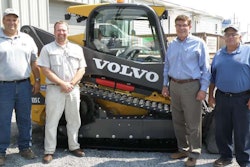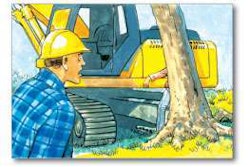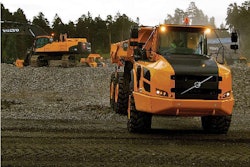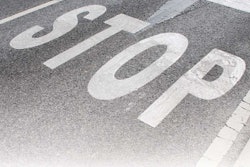What your truck tire treads are trying to tell you
Correctly reading and interpreting tire wear can save you money
By Jack Roberts
Your truck and trailer tires are a virtual wealth of information, and can give you clues on driver behavior, alignment issues, worn components and even improperly spec’d tires.
Make sure your truck drivers carefully inspect tires. “They need to rub their hands on the tires to see if there is any feathering, or cupping or diagonal wear,” says Doug Jones, Michelin’s customer engineering support manager for North America, ”then alert a technician if they find any suspicious wear patterns.”
Truck tires also can expose bad driving habits and poor tire care, including high power or jackrabbit starts, brake skids or lack of regular inflation. “And if you’ve spec’d a tire improperly, you will quickly see an increased wear rate,” says Curtis Decker, commercial tire product development engineer for Continental.
Not taking the time to examine your tires – or ignoring the problems your tires are identifying for you – not only increases your costs but also the potential for safety issues.
Identify the common types of tread wear and the problems behind them
Feather Wear
Feather wear is easy to detect – but a technician actually has to put his hands on the tire and rub them up and down to diagnose this problem correctly. Generally speaking, feather wear is an alignment issue, usually because of a bad toe condition. Toe-in occurs where two tires are turned in so their front edges are closer together than the rear edge. Toe-out is the opposite condition. The wear pattern is similar to the way a bird’s feathers overlap: when a technician rubs his hand over the tire, he will feel it is smooth in one direction, and rough when he rubs his hand back against the grain created by the toe condition. A good rule of thumb: Smooth-in means a toe-in condition, while smooth-out means toe-out. Feather wear also can be caused by side-scrubbing or severe drive axle misalignment.
Diagonal Wear
Diagonal wear typically shows up as localized flat spots that cross the tread of a tire in diagonal pattern. Diagonal wear generally is inflicted by mechanical forces from the drivetrain affecting the tire. Because they repeat in a frequency, they continually show up in the same locations on the tire. Some causes could be worn or improperly adjusted bearings, or differing overall diameters of the tires combined in the dual position. It also could be a mismatch or improper inflation. Diagonal wear is often slow to develop and can be aggravated by alignment issues.
Sidewall Wear
Most sidewall wear is damage related; primarily from scrubbing or curbing. Driver practices are usually key to avoiding this type of damage – although some applications where curbing is a given – such as operating in tight urban surroundings – you may want tires with features that can withstand additional curbing, such as a protective curb rib. Excessive curbing can cause pinch shock, a condition where a tire’s sidewall is subjected to abnormally heavy loads, resulting in a crimped core. It’s like bending a coat hanger and then trying to restore it to its original state: the wire can’t be straightened back out. Likewise, the tire’s core stays “pinched,” accelerating abnormal wear and weakening the tire’s overall integrity.
Thrust Angle and Scrub Angle Wear
Thrust angle issues occur when a truck’s drive axles, through improper alignment, cause the truck to want to deviate from a straight path. In other words, the drive axles are attempting to thrust the truck out of line and the driver has to constantly correct for this with the steering wheel. Thrust angle tends to show itself when one steer tire is worn on its inside and the other is worn on the outside. This is different from toe wear’s symmetrical wear pattern; with thrust angle, the wear is independent of the side of the truck where the tire is located. Accelerated wear is found on the outside of one drive tire, and on the inside of the opposite drive tire.
Tandems should be square when they’re properly mounted on a vehicle; they should be perpendicular to the frame and parallel to each other. Scrub comes into play when one of the axles is not parallel to the other axle. So a tire on one side of the vehicle is rolling in a larger diameter than on the other side, causing the vehicle to attempt to turn in circles, creating an extremely tortuous condition for the tire in question. Scrub angle problems generally show up as diagonal wear across the tread of a tire, but diagnosing the condition can be tricky as worn axle components also show up as diagonal wear.
Dog Tracking
Dog tracking occurs when a tractor’s rear axles are not properly aligned with the axles of the trailer it is pulling; the tractor is attempting to drive down the road in a straight line, while the trailer behind is attempting to track off a few degrees to the right or the left. In severe cases, dog tracking can be so bad a driver on a straight road can see more of one side of the trailer in his rearview mirrors than the other. Signs of dog tracking can be easily confused with thrust angle wear. The best way to determine which problem you’re facing is to evaluate the vehicle’s driving characteristics: If the truck pulls constantly in one direction, the problem is in the mounting of the drive axles. If the vehicle wanders all over the road, the problem is most likely an alignment issue in the trailer axles.
Camber
Camber is the outward or inward tilt of a tire. Tires should be straight up and down. If they are tilted in at the top, that is negative camber. If they tilted in at the bottom, that’s positive camber. Although a little positive camber is desired for a loaded vehicle, the tires have a tendency to go negative. Too much positive camber will lead to smooth wear, usually on the outside of one of the tires, and it can be severe enough it will be found on both tires. In most cases, the symptoms are seen on one tire only.
Cupping Wear
Cupping results from an up-and-down motion affecting the tire and its contact with the road surface. A bad shock absorber, air springs or suspension system usually is to blame, creating vibrations that cause the tire to bounce up and down as it travels down the road. This type of wear usually shows up on steer and trailer tires and appears as series of high and low spots on around the tread surface of the tire.
Flat Spotting
As the name of this condition indicates, flat spotting starts off as a single, scrubbed band of tread running across the tire that is shallower than the tread area immediately surrounding it. This affected area will clearly be flatter than the tire surface surrounding it. In most cases, flat spotting is a created by a brake issue; most of the time, a foundation brake is locked up or dragging, although a severe panic stop – or a driver who has a habit of over-aggressive braking – can create the problem. If a brake check fails to identify any maintenance issues, then a safety refresher with the driver may be in order to moderate his braking habits.










